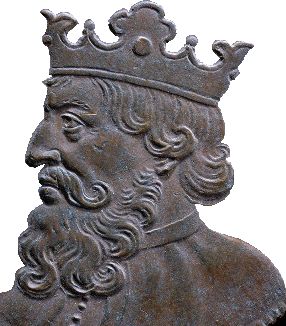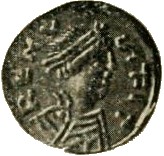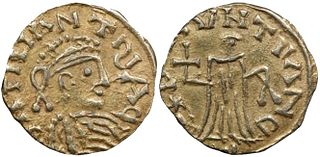Related Research Articles
The 580s decade ran from January 1, 580, to December 31, 589.

Gregory of Tours was a Gallo-Roman historian and Bishop of Tours during the Merovingian period and is known as the "father of French history." He was a prelate in the Merovingian kingdom, encompassing Gaul's historic region.

Clotilde, also known as Clothilde, Clotilda, Clotild, Rotilde etc., was a Queen of the Franks. She was supposedly descended from the Gothic king Athanaric and became the second wife of the Frankish king Clovis I in 493. The Merovingian dynasty to which her husband belonged ruled Frankish kingdoms for over 200 years (450–758).

Chlothar II, sometime called "the Young", was king of the Franks, ruling Neustria (584-629), Burgundy (613-629) and Austrasia (613-623).

Chilperic I was the king of Neustria from 561 to his death. He was one of the sons of the Frankish king Clotaire I and Queen Aregund.

Childebert II (c.570–596) was the Merovingian king of Austrasia from 575 until his death in March 596, as the only son of Sigebert I and Brunhilda of Austrasia; and the king of Burgundy from 592 to his death, as the adopted son of his uncle Guntram.

Gundobad was King of the Burgundians, succeeding his father Gundioc of Burgundy. Previous to this, he had been a patrician of the moribund Western Roman Empire in 472 – 473, three years before its collapse, succeeding his uncle Ricimer. He is perhaps best known today as the probable issuer of the Lex Burgundionum legal codes, which synthesized Roman law with ancient Germanic customs. He was the husband of Caretene.

Sigebert I was a Frankish king of Austrasia from the death of his father in 561 to his own death. He was the third surviving son out of four of Clotaire I and Ingund. His reign found him mostly occupied with a successful civil war against his half-brother, Chilperic.
Fredegund or Fredegunda was the queen consort of Chilperic I, the Merovingian Frankish king of Soissons. Fredegund served as regent during the minority of her son Chlothar II from 584 until 597.

Saint Gontrand, also called Gontran, Gontram, Guntram, Gunthram, Gunthchramn, and Guntramnus, was the king of the Kingdom of Orléans from AD 561 to AD 592. He was the third-eldest and second-eldest-surviving son of Chlothar I and Ingunda. On his father's death in 561, he became king of a fourth of the Kingdom of the Franks, and made his capital at Orléans. The name "Gontrand" denotes "War Raven".

Venantius Honorius Clementianus Fortunatus, known as Saint Venantius Fortunatus, was a Latin poet and hymnographer in the Merovingian Court, and a bishop of the Early Church who has been venerated since the Middle Ages.
Brunhilda was queen consort of Austrasia, part of Francia, by marriage to the Merovingian king Sigebert I of Austrasia, and regent for her son, grandson and great-grandson.

Gundoald or Gundovald was a Merovingian usurper king in the area of southern Gaul in either 584 or 585. He claimed to be an illegitimate son of Chlothar I and, with the financial support of the Emperor Maurice, took some major cities in southern Gaul, such as Poitiers and Toulouse, which belonged to Guntram, king of Burgundy, a legitimate son of Chlothar I. Guntram marched against him, calling him nothing more than a miller's son and named him 'Ballomer'. Gundovald fled to Comminges and Guntram's army set down to besiege the citadel. The siege was successful, Gundovald's support drained away quickly and he was handed over by the besieged to be executed.
Basina, was a Frankish princess, the daughter and youngest child of Chilperic I, King of Soissons, and his first wife, Audovera. After surviving the assassination of her immediate family, she became a nun. She later helped to lead a rebellion by a group of the nuns, which became a scandal throughout the region. This event was chronicled by the bishop and saint, Gregory of Tours, who was one of the bishops chosen to settle the matter.

Saint Prætextatus, also spelled Praetextatus, Pretextat(us), and known as Saint Prix, was the bishop of Rouen from 549 until his assassination in 586. He appears as a prominent character in Gregory of Tours’ Historia Francorum. This is the principal source from which information on his life can be drawn. He features in many of its most notable passages, including those pertaining to his trial in Paris and his rivalry with the Merovingian Queen Fredegund. The events of his life, as portrayed by Gregory of Tours, have been important in the development of modern understandings of various facets of Merovingian society, such as law, the rivalry between kings and bishops, church councils, and the power of queens.

Garibald I was Duke of Bavaria from 555 until 591. He was the head of the Agilolfings, and the ancestor of the Bavarian dynasty that ruled the Kingdom of the Lombards.
Mummolus, was a Gallo-Roman patrician and prefect who served Guntram, King of Burgundy, as a general in the 6th century.

Palladius or more often in French Pallais was a 6th-century bishop of Saintes. According to Gregory of Tours, the family of Palladius was wealthy, and had produced several bishops and teachers throughout the 5th century in Gaul.
Ragnemod was a 6th-century bishop of the archdiocese of Paris.
Faustianus was a bishop of the former diocese of Dax in the 6th century.